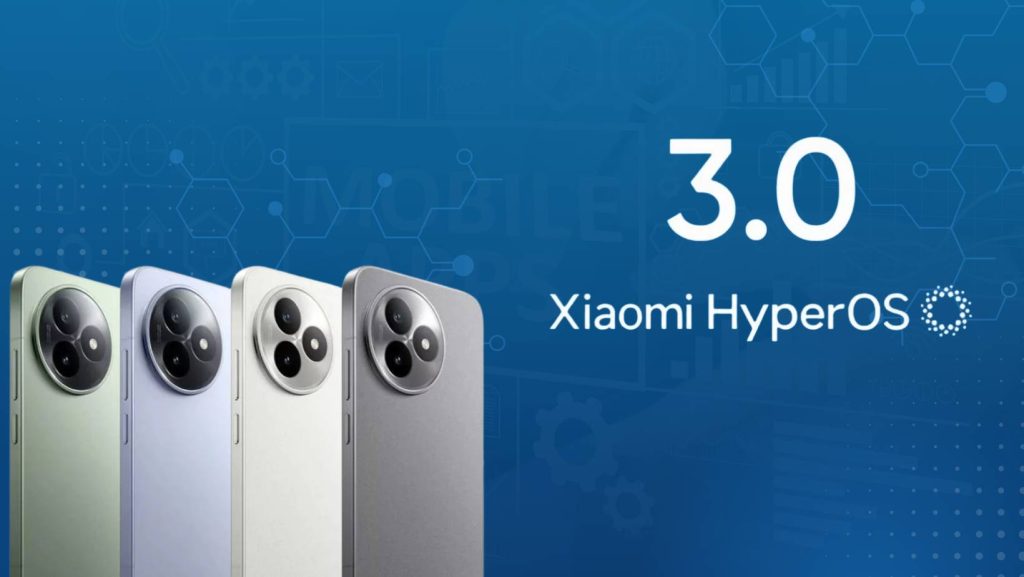Xiaomi has always been known for pushing innovation not just in hardware but also in software. With the launch of Xiaomi HyperOS 3.0, built on Android 16, the company has made one of its most ambitious moves yet. This new update is designed to replace older versions of MIUI and further evolve HyperOS into a platform that is faster, smarter, and more tightly integrated with the Xiaomi ecosystem.
Unlike past updates that were mainly cosmetic, Xiaomi HyperOS 3.0 Android 16 introduces system-level changes that improve everything from performance and battery life to personalization and security. For Xiaomi, Redmi, and POCO users, the biggest question is not whether HyperOS 3.0 is an improvement—it’s about whether their phone is eligible and how they can get the update installed smoothly.
This guide will give you a complete roadmap: features, eligible phones, regional rollouts, installation steps, and everything you should know before upgrading.
What’s New in Xiaomi HyperOS 3.0 (Android 16)
Xiaomi has integrated many of Android 16’s newest capabilities while adding its own unique flavor to make xiaomi hyperos 3.0 stand out. Some of the most exciting improvements include:
- Super Island (Dynamic Overlay): Xiaomi’s “Super Island” is a fresh take on Apple’s Dynamic Island. It shows live notifications, music playback, delivery tracking, and more in a small floating interface that adapts based on the app. This reduces the need to switch apps and creates a seamless multitasking experience.
- Widgets 2.0: Widgets are no longer static. In HyperOS 3.0, widgets are fully interactive. For example, you can check live weather, control smart home devices, or even reply to messages without opening the full app. Xiaomi has also improved widget theming, allowing them to automatically match wallpapers and system colors.
- Battery & Performance Optimizations: Xiaomi claims xiaomi hyperos 3.0 has redesigned its resource management system. It uses AI-based algorithms to limit background activity intelligently, ensuring that heavy apps like games don’t slow down other tasks. This results in smoother scrolling, faster app launches, and up to 15% better battery endurance.
- Cross-Device Continuity: Imagine starting a note on your Xiaomi phone and finishing it on your Xiaomi Pad or even a smart TV. HyperOS 3.0 brings this Apple-like ecosystem experience to Android users. You can transfer calls, continue watching videos, or share files instantly between devices.
- AI-Powered Features: AI is integrated deeply into HyperOS 3.0. You can now remove unwanted objects from photos using Xiaomi’s built-in AI editor, get smart text suggestions while typing, and even enjoy improved real-time translations during calls.
- Enhanced Security & Privacy: Security has been strengthened with Android 16’s privacy controls combined with Xiaomi’s improvements. Apps now require stricter permissions, and there is better isolation between apps, which means malicious software cannot easily exploit the system.
These changes are not just visual upgrades—they fundamentally improve how Xiaomi devices interact with users on a daily basis.
Xiaomi HyperOS 3.0 Android 16 Eligible Phones List
One of the most asked questions around every major update is: “Will my phone get it?” Xiaomi has confirmed that xiaomi hyperos 3.0 android 16 will be rolled out gradually, with newer and more powerful devices taking priority. Here’s the detailed eligibility list:
Xiaomi Flagship Devices
Xiaomi always prioritizes its premium lineup, so users with recent flagship models will be the first to experience the update.
- Xiaomi 14, Xiaomi 14 Pro, Xiaomi 14 Ultra: These are the first devices to ship with HyperOS 3.0 pre-installed and will also receive the earliest refinements.
- Xiaomi 13 Series (13, 13 Pro, 13 Ultra): These powerful devices, already running on Snapdragon 8 Gen 2 chips, will handle HyperOS 3.0 effortlessly.
- Xiaomi 12 Series (12, 12 Pro, 12S Ultra): Though slightly older, these remain eligible due to strong hardware capabilities.
- Xiaomi Mix Fold 3 and Mix Fold 2: Xiaomi’s foldable devices are a major part of its ecosystem strategy and will be upgraded with features tailored for multitasking and split-screen usage.
Redmi Devices
Redmi is Xiaomi’s budget-friendly yet feature-rich sub-brand, and many of its popular models are eligible:
- Redmi Note 13 Pro and Note 13 Pro+: Being the latest Note lineup, these are high on the update priority list.
- Redmi Note 12 Pro and Note 12 Turbo: Mid-range models that balance affordability with performance, perfect for HyperOS 3.0.
- Redmi K60 Series (K60, K60 Pro, K60 Ultra): Positioned as “flagship killers,” these devices will make great use of the new features.
- Redmi Note 11 Pro+ and 11T Pro: Though older, these models are still within Xiaomi’s 2–3 year update cycle.
POCO Devices
POCO users also have reason to celebrate. The following models are confirmed to get xiaomi hyperos 3.0 android 16:
- POCO F5 and F5 Pro: POCO’s most performance-oriented devices, ideal for testing HyperOS 3.0’s gaming optimizations.
- POCO X5 and X5 Pro: These mid-range models are included due to their popularity in global markets.
- POCO X4 GT and M6 Pro: Affordable but powerful devices that will benefit from improved battery optimization.
Tablets & Foldables
Xiaomi is making sure HyperOS 3.0 works well beyond smartphones.
- Xiaomi Pad 6, Pad 6 Pro, and Pad 6 Max: Larger screens will benefit from improved multitasking features and optimized widgets.
- Xiaomi Pad 5 and Pad 5 Pro: Still within Xiaomi’s active update cycle, making them eligible.
- Mix Fold Series: Foldable devices gain customized multitasking UI enhancements under HyperOS 3.0.
Regions & Rollout Timeline
Xiaomi rarely rolls out updates globally at once. Instead, the company uses a phased approach to ensure stability.
- China First: Flagship Xiaomi 14 and Xiaomi 13 series users in China have already started receiving the beta builds of HyperOS 3.0 Android 16.
- India and Europe Next: Given Xiaomi’s huge market presence in these regions, Redmi and POCO devices will start receiving the stable update in phases by late 2025.
- Global Release: Devices sold in Latin America, Africa, and Southeast Asia will see the rollout slightly later, typically a few months after the European release.
It’s also important to remember that carrier-specific approval may delay rollout in certain markets. Xiaomi usually completes global rollouts within 6–8 months.
How to Check If Your Phone is Eligible
Many users are often unsure if their device is part of the update program. Xiaomi makes it easy to check eligibility:
- System Update Menu: Go to Settings → About Phone → System Update. If your device is eligible, you will see “Xiaomi HyperOS 3.0” available for download.
- Xiaomi Community App: This app provides news on beta testing programs, early rollout schedules, and confirmed device lists.
- Official Xiaomi Website: Xiaomi updates its official update roadmap regularly, where you can search for your device model.
If you do not see the update yet, don’t panic—it may still be in the rollout queue for your region.
Installation Guide for Xiaomi HyperOS 3.0 Android 16
Installing xiaomi hyperos 3.0 android 16 can be done in two ways: OTA (automatic update) or manual installation.
Prerequisites Before Installation
Before starting, ensure:
- Backup your data: Always create a backup via Mi Cloud or Google Drive to prevent data loss.
- Charge your device: A minimum of 50% battery is recommended to avoid interruptions.
- Storage space: Ensure at least 5–8 GB of free space as updates can be large.
- Current software: Your phone should be on the latest version of MIUI/HyperOS before upgrading.
Step-by-Step OTA Installation
- Open Settings → About Phone → System Update.
- Tap Check for Updates.
- If available, click Download & Install.
- Your device will automatically reboot and install the new version.
Manual Installation (Recovery/Fastboot ROM)
For users who don’t want to wait for the OTA rollout:
- Download the official ROM file from Xiaomi’s website.
- Move it to your device’s internal storage.
- Open System Update and select Choose Update Package.
- Select the ROM file and begin installation.
This method is usually used by advanced users who want early access or if the OTA hasn’t arrived in their region yet.
Troubleshooting Issues
- Boot Loop or Stuck at Logo: Enter recovery mode and clear cache.
- Not Enough Storage: Delete unnecessary apps or transfer files to cloud storage.
- Rollback Option: If HyperOS 3.0 feels unstable, Xiaomi provides fastboot ROMs to downgrade safely.
Key Benefits After Installing HyperOS 3.0 Android 16
Once successfully installed, users will notice significant improvements:
- Faster System Performance: Smoother app launches, animations, and scrolling across the UI.
- Extended Battery Life: AI-based optimization ensures apps don’t drain power unnecessarily.
- Enhanced Multitasking: Larger-screen devices like tablets and foldables benefit from better multitasking modes.
- Customization at Your Fingertips: Themed icons, Super Island, and resizable widgets provide a highly personal experience.
- Tighter Security: Improved app permissions, sandboxing, and phishing protection keep your device safer.
These benefits make the update a must-have for anyone eligible.
Should You Upgrade Now or Wait?
While the idea of upgrading immediately is tempting, not all users should rush:
- Pros of Early Upgrade: Access to all the new features, improved performance, and being among the first to experience Xiaomi’s most advanced system yet.
- Cons of Early Upgrade: Beta versions may contain bugs, causing occasional instability. Apps may also have compatibility issues early on.
If your phone is your daily driver, it may be wise to wait for the stable global rollout. Advanced users and enthusiasts, however, can enjoy the beta experience without major risks.
FAQs
1. What is Xiaomi HyperOS 3.0?
Xiaomi HyperOS 3.0 is the latest version of Xiaomi’s custom software skin built on Android 16. It offers new features like Super Island, interactive widgets, better battery management, cross-device continuity, and stronger security upgrades compared to previous versions.
2. Which phones will get Xiaomi HyperOS 3.0 Android 16?
The update will first roll out to Xiaomi flagships (Xiaomi 14, 13, 12 series), followed by Redmi Note 13, Note 12, K60 series, and POCO F5, X5, and select tablets like Xiaomi Pad 6. Older budget devices may not be eligible.
3. How can I check if my phone is eligible for HyperOS 3.0?
You can check by going to Settings → About Phone → System Update. If eligible, you’ll see the update option for Xiaomi HyperOS 3.0. Xiaomi’s official website and community app also provide eligibility lists.
4. When will Xiaomi HyperOS 3.0 Android 16 be released globally?
The update starts in China with flagship devices, then expands to India, Europe, and global markets. Stable global rollout is expected by late 2025, though timelines vary by region.
5. How do I install Xiaomi HyperOS 3.0 on my phone?
The easiest way is OTA (Over-the-Air) via Settings → System Update. Advanced users can install manually using recovery or fastboot ROMs downloaded from Xiaomi’s official site.
6. What are the main benefits of upgrading to HyperOS 3.0 Android 16?
Users will notice smoother UI, better multitasking, improved gaming, longer battery life, AI-powered tools, interactive widgets, and enhanced privacy features.
7. Is it safe to install HyperOS 3.0 manually?
Yes, if you use official Xiaomi ROMs. However, forcing installation on unsupported devices can cause errors or even brick your phone. Always back up data before upgrading.
8. Will older Redmi or POCO phones get HyperOS 3.0?
Most older devices beyond 2–3 years may not receive HyperOS 3.0. Xiaomi focuses on newer models like Redmi Note 12/13 and POCO F/X series.
9. Can I roll back if HyperOS 3.0 is unstable?
Yes, Xiaomi provides official fastboot ROMs for rollback. This is useful if you face bugs in beta builds, but you should carefully follow Xiaomi’s instructions.
10. How long will Xiaomi support devices running HyperOS 3.0 Android 16?
Flagship devices will get 3–4 years of OS updates and 5 years of security patches. Mid-range and budget models usually get 2–3 years of updates.




